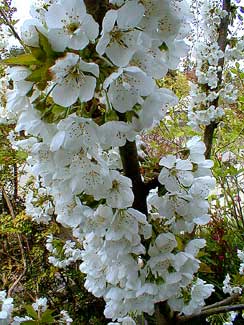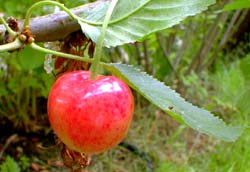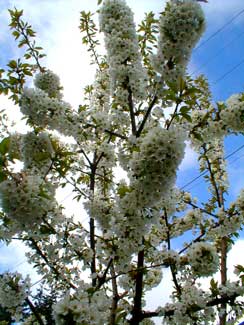
'Rainier' & 'Queen Anne'
Cherry Trees
"Kwan Yin's tiled temple
roof floats far away in clouds
of cherry blossoms."
-Matsuo Basho,
1644-1694
1644-1694
Very shortly after we bought the house we went on a journey to buy the first of many trees we would over time be planting. We loved the idea of having trees that so cared about us that they'd feed us, & decided upon sweet cherries.
We selected 'Rainier' & 'Queen Anne' which look pretty much identical, & which cross-pollinate well. These years later I still remember them sticking out from the hatchback as I road in back amidst the leaves, struggling to hold the hatchback-door opened & upward so that it wouldn't mash down on the tall slender saplings.
We've long since forgotten with certainty which is which; we think the 'Rainier' grows to the south of the 'Queen Anne,' & if so, the blossom photo at the top of the page (2003) is 'Rainier,' & the third photo below (2004) is the 'Queen Anne.'
 Both trees are just thick with white cherry blossoms in April, & they both produce creamy-yellow & pink bicolored cherries of the sweetest kind. We have to pick them fast when they are ripening in June, as birds love them too.
Both trees are just thick with white cherry blossoms in April, & they both produce creamy-yellow & pink bicolored cherries of the sweetest kind. We have to pick them fast when they are ripening in June, as birds love them too.'Rainier' was originally developed by Dr. Harold W. Fogle of the Washington State University Research Station in Prosser, Washington, specifically to crosspollinate with Bing Cherries, the Bing being the best loved of all sweet cherries. However, 'Rainier' soon achieved a separate fame as a gourmet cherry.
Although there are about 1,000 sweet cherry varieties, the Rainier, Lambert, & Bing together make up about 95% of the sweet cherries growing in Washington & Oregon. Plus, the Pacific Northwest produces about 70% of the cherries sold in grocery stores throughout the Americas.
 'Queen Anne' is often used to make marachino cherries because they bleach easily. There is a widespread belief that as fresh cherries, 'Rainier' outranks 'Queen Anne,' though I can go from one tree to the other sampling the fruit, & not confirm which is the 'Rainier' on any basis of one being better than the other. Indeed, distributors of grocery produce commonly place Queen Anne cherries in the grocery stores as Rainiers because the latter are more famous, & no one seems to notice the difference.
'Queen Anne' is often used to make marachino cherries because they bleach easily. There is a widespread belief that as fresh cherries, 'Rainier' outranks 'Queen Anne,' though I can go from one tree to the other sampling the fruit, & not confirm which is the 'Rainier' on any basis of one being better than the other. Indeed, distributors of grocery produce commonly place Queen Anne cherries in the grocery stores as Rainiers because the latter are more famous, & no one seems to notice the difference.There was a time when 'Bing' & 'Rainier' did not yet exist, & it was the Queen Anne cherry that ruled. It is by far the older variety & was earlier known as 'Napoleon,' or 'Napoleon Bigarreau.'
It had its name changed to 'Royal Anne,' eventually ammended to 'Queen Anne,' by nurseryman Henderson Lewelling when he established his pioneering orchard in Salem, Oregon, in 1847. It is from Lewelling's renamed 'Royal Anne' that even the Bing & Lambert are derived, & scores of other varieties.
These popular cultivars were developed from Prunus avium, the sweetest of the wild cherries, native of the British Isles & Eurasia. The pure wild form is rarely gardened.
All cherries contain Cyanogenic glycoside, a very toxic chemical found in the leaves, limbs, roots, & cherry pits, but the ripened fruit as we all know is completely nontoxic.
See also the
Cherry Tree Page along the Winter Bark Garden Walk
as well as the
Prunus avium in the autumn trees gallery